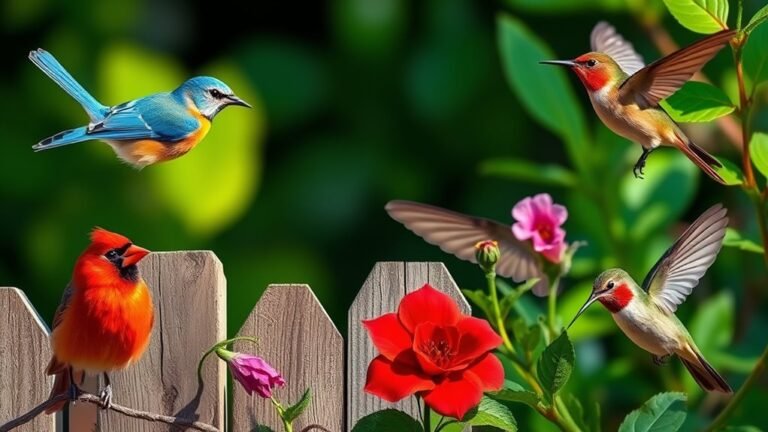Dark Red Birds With Black Heads: a Visual Guide
Dark red birds with black heads present a fascinating array of species, each showcasing their unique traits and behaviors. These birds often exhibit vibrant colors and fulfill important roles in their ecosystems. For example, the Scarlet Tanager has a bold look that reveals details about its mating habits and preferred habitats. As we learn about these birds, we can appreciate the ways their features support their survival in nature.
Key Takeaways
- The Scarlet Tanager features bright red feathers and a black head when seen from a distance, fitting the description of dark red with black accents.
- The Black-headed Grosbeak showcases a striking contrast between its golden-orange body and prominent black head, making it another candidate of interest.
- Crimson-collared Grosbeak has a vivid coloration, though not strictly dark red; its black head adds to its visual appeal.
- These birds typically inhabit forests and gardens, with the Black-headed Grosbeak often found in oak and pine areas.
- Observing their behaviors, such as melodious songs, enhances the experience of birdwatching and identifying these colorful species.
The Scarlet Tanager: A Vibrant Summer Visitor

During summer, the Scarlet Tanager is a striking sight in North America. This bird has bright red feathers that stand out against its black wings and tail.
You'll find these tanagers in deciduous and mixed forests, where they live among the leafy trees. Their homes provide plenty of food, such as insects and berries, which are important for their growth and energy.
Listen for their unique song, a sweet, whistled tune that travels through the trees. Seeing a Scarlet Tanager connects you to nature's beauty and brings joy to birdwatchers who enjoy these seasonal guests.
The Crimson-collared Grosbeak: A Colorful Resident
The Crimson-collared Grosbeak is a colorful bird found in Central America. It lives in subtropical and tropical forests. This bird thrives in areas with dense foliage and open spaces.
The Crimson-collared Grosbeak is known for its sociable nature. It often forages in groups with other bird species, looking for seeds, fruits, and insects to eat. Its call consists of a series of melodious whistles. These sounds help mark its territory and communicate with other birds.
The Grosbeak's bright colors enhance the beauty of the environment and show its ability to adjust to various habitats. Learning about the Crimson-collared Grosbeak deepens your appreciation for the diverse birdlife in Central America.
The Black-headed Grosbeak: A Melodious Marvel

The Black-headed Grosbeak is known for its bright colors and beautiful songs. This bird produces melodious tunes that fill forests and brushy areas.
It prefers environments like oak and pine forests and riverbanks, where it blends into the surroundings. You can easily spot its contrasting features: a dark black head and warm golden-orange body. These colors help in attracting mates and hiding from predators.
Black-headed Grosbeaks appear most often during migration and breeding times, giving you chances to see their vibrant plumage and hear their charming calls.
Listening to their songs helps you connect with nature and appreciate bird life even more.
The Red-billed Firefinch: A Small Gem of the Savanna
The Red-billed Firefinch (Lagonosticta senegala) lives in the grasslands of sub-Saharan Africa. This striking bird often moves through thick grasses and shrubs. It searches for seeds and insects as part of its diet.
The firefinch thrives in various habitats, including open savannas and agricultural fields.
These birds are social creatures. They prefer to form small flocks and engage in lively interactions. During the breeding season, male firefinches display their bright colors to attract females. They chirp and call as part of their courtship.
Observing Red-billed Firefinches helps you appreciate the savanna ecosystem. Their beauty adds joy to your connection with nature.
The Red-capped Robin-chat: A Charming Garden Resident

The Red-capped Robin-chat (Cossypha natalensis) is a delightful bird often found in gardens and wooded areas. Its bright colors and beautiful song attract birdwatchers.
Observing this bird can enhance your gardening experience. Here are four important traits to note:
- Vocalization: The Red-capped Robin-chat has a sweet, whistling song that signals its presence.
- Foraging Style: This bird forages on the ground, looking for insects and worms, which shows its resourcefulness.
- Territorial Display: Males puff up their feathers to display their territory, which is an impressive sight.
- Nesting Behavior: It usually nests in low shrubs, making the nests easier to spot.
Engaging with the Red-capped Robin-chat can deepen your connection with nature and enrich your gardening experience.
Frequently Asked Questions
What Habitats Do These Dark Red Birds Prefer?
These dark red birds live in dense forests and shrubby areas. They prefer places that help them breed. They usually build their nests in hidden spots, like tree cavities or thick bushes, to stay safe and sheltered.
How Can I Attract These Birds to My Garden?
To attract birds to your garden, place feeders near bushes and trees. Use native plants for food and shelter. Keep feeders clean and filled to create a reliable food source. This will help make your garden a friendly place for birds. Enjoy watching them visit!
Are These Species Migratory or Resident Birds?
These species show different migratory behaviors based on environmental conditions. Some birds stay in the same area all year, while others move to different locations seasonally to breed or find food. Knowing their habits can help you attract them to your garden more effectively.
What Do These Birds Typically Eat?
These birds eat a variety of foods. Their diet mainly includes seeds, fruits, and insects. They choose different foods based on the season. This ability helps them stay healthy and supports their breeding success.
How Can I Identify Female Dark Red Birds?
To identify female dark red birds, look at their feather patterns. These birds usually have differences in color and design compared to males. Notice these details to improve your understanding and appreciation of them. Observing their size and behavior can also help in identifying them. Enjoy watching these beautiful birds in nature!

Hello, I’m Amelia White, the founder of birdsfanatic.com. As a lifelong bird enthusiast and spiritual seeker, I’ve always been fascinated by the mystical connections between birds and the human experience. On this site, I share my knowledge and insights into the symbolic meanings and spiritual significance of various bird species, exploring their roles in mythology, folklore, and cultural traditions. Join me on this journey into the world of birds, where we’ll discover the hidden wisdom and guidance that these magnificent creatures have to offer.







